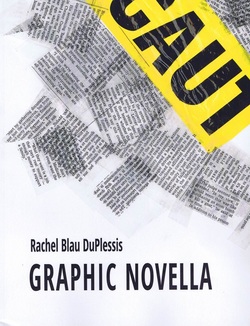
This multi-genre text begins with a collagist-narrator in search of plot. It ends overwhelmed by plot, as her collaged fragments repeatedly reveal the inter-related climatological and discursive apocalypses that await humankind. The narrator finds herself creating a desperation text, one that seems to her socially useless yet personally essential. Cassandra-like, she is condemned to foresee in her fragments the likely collapse of civilization while lacking the ability to communicate what she foresees. There's a sly allusion here to – and probable critique of – the ending of The Waste Land.
In a perhaps unintended way, Graphic Novella is also a commentary on the predicament of contemporary innovative writing, a writing which must draw on all its complexities to respond to the unprecedented changes this possibly final phase of the industrial revolution is bringing down on global culture, but which is consequently unreadable by most of the citizens of that culture. “How can one even begin to write this – it is only to imitate the half-collapsed. The helpless hand. O O O that corny poetics of mimesis” (28) the narrator laments.
At the beginning of the novella the narrator’s collages occupy the right-hand page and her often surprised and dismayed readings of them the left-hand one. But as her confidence in her artistry
As well, Graphic Novella is an unstated commentary on the subtlety of the politics of much contemporary visual poetry, such as that of Derek Beaulieu. The creator of these collages can barely endure the political implications of her initial ‘innocent’ creations, cannot restrain herself from commenting on them, or from moving on to longer narratives – such as that of a slum clearance in South Africa (106) whose designers announced “This eradication directed toward a re-vitalizing process we have, following Le Corbusier, named the Surgical Method.” The citation leads her to comment, with evident sarcasm, “A certain kind of modernism has a lot to answer for.” The risk, however, of such political explicitness, is of addressing only like-minded readers – which of course returns a reader to one of the “literary” dilemmas this book addresses.
Unrepresentable is everything.
And when one simply “suggests”
by the casualness, the thin sketch,
the “gesture towards,”
the inadequacies make it worse. (80)
This is an intriguingly timely book, one that should be read by writers not only for its genre hybridities – poem, collage, prose – but also for the narrator’s troubled reflections on mimesis which underpin these. The crisis it perceives (and enacts) in representation both dwarfs and enfolds the numerous ‘crises’ that one hears mooted in various political, economic, scientific, and literary-theory contexts. The Graphic Novella confronts the deadly impossibility of being sufficiently 'graphic'.
FD
 RSS Feed
RSS Feed